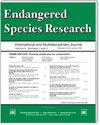Combining reproductive endocrinology and ROC analysis to identify changes with sex, age, and pregnancy status in botos Inia geoffrensis
IF 2.9
2区 环境科学与生态学
Q2 BIODIVERSITY CONSERVATION
引用次数: 0
Abstract
ABSTRACT: Reproductive hormone profiles were described against physical characteristics during growth and development in male and female botos (Amazon River dolphins Inia geoffrensis) and during pregnancy. We determined hormone concentrations in 226 wild botos located in Mamirauá Reserve, Amazonas State, Brazil, as a part of the long-term population monitoring program known as Projeto Boto. Additionally, we applied receiver operator characteristic (ROC) analysis to compare diagnostic probabilities of using ultrasound, hormones, or combinations of these to detect pregnancy. Based on single-point analysis of serum testosterone (T), males with <2.5 ng ml-1 T and a mean 163 cm total body length were classified as immature, 2.5 to <4.9 ng ml-1 T and 183 cm as pubescent, and >5 ng ml-1 T and 227 cm as adult botos. For females, only progesterone (P4), T, relaxin (Rlx), and the combination of P4 × T2 were significantly different between non-pregnant and pregnant females, but androstenedione (A4) and the P4:T ratio were not. ROC analysis indicated that ultrasound and P4 × T2 were considered excellent as pregnancy diagnostic tests, and P4, T, and Rlx were classified as good predictors. Results indicated that negative and positive predictive probabilities from each diagnostic test could be used to accurately predict a pregnancy and calf loss rate of 13% for this population. Application of these methods for evaluating wild population reproductive success from a single serum sample can now be used for health evaluations of wild populations of boto and provide timely information for the development or evaluation of any conservation initiatives.将生殖内分泌学和 ROC 分析相结合,识别雌鼠性别、年龄和怀孕状态的变化
摘要:我们根据雌雄斑纹海豚(亚马逊河海豚Inia geoffrensis)生长发育期间和怀孕期间的身体特征描述了生殖激素谱系。我们测定了位于巴西亚马孙州马米劳亚保护区的 226 头野生斑纹海豚的激素浓度,这是名为 "Projeto Boto "的长期种群监测项目的一部分。此外,我们还应用受体运算特征(ROC)分析比较了使用超声波、激素或它们的组合检测怀孕的诊断概率。根据血清睾酮(T)的单点分析,体长为2.5 ng ml-1 T、平均体长为163厘米的雄性为未成年,体长为2.5至4.9 ng ml-1 T、平均体长为183厘米的为青春期,体长为5 ng ml-1 T、平均体长为227厘米的为成年雌性。就雌性而言,只有孕酮(P4)、T、松弛素(Rlx)以及 P4 × T2 的组合在未孕雌性和妊娠雌性之间存在显著差异,但雄烯二酮(A4)和 P4:T 的比值没有显著差异。ROC 分析表明,超声波和 P4 × T2 被认为是极佳的妊娠诊断测试,而 P4、T 和 Rlx 被归类为良好的预测指标。结果表明,每种诊断测试的阴性和阳性预测概率可用于准确预测该种群 13% 的妊娠率和犊牛损失率。应用这些方法从单份血清样本中评估野生种群的繁殖成功率,现在可用于野生波图种群的健康评估,并为制定或评估任何保护措施提供及时的信息。
本文章由计算机程序翻译,如有差异,请以英文原文为准。
求助全文
约1分钟内获得全文
求助全文
来源期刊

Endangered Species Research
BIODIVERSITY CONSERVATION-
CiteScore
5.50
自引率
6.50%
发文量
38
审稿时长
31 weeks
期刊介绍:
ESR is international and interdisciplinary. It covers all endangered forms of life on Earth, the threats faced by species and their habitats and the necessary steps that must be undertaken to ensure their conservation. ESR publishes high quality contributions reporting research on all species (and habitats) of conservation concern, whether they be classified as Near Threatened or Threatened (Endangered or Vulnerable) by the International Union for the Conservation of Nature and Natural Resources (IUCN) or highlighted as part of national or regional conservation strategies. Submissions on all aspects of conservation science are welcome.
 求助内容:
求助内容: 应助结果提醒方式:
应助结果提醒方式:


